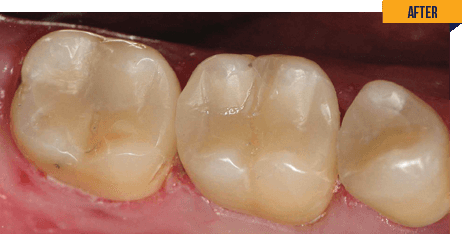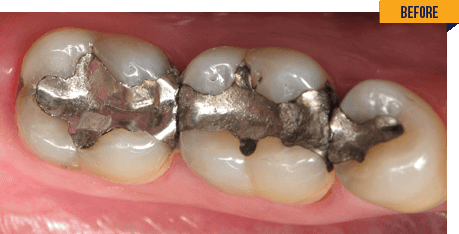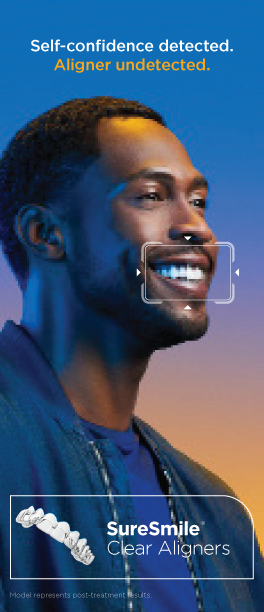Our Services
At Broadbent Family Dental, we are committed to your oral health. Dr. Broadbent continues to apply a special focus on the type of treatments his patients deserve. Implementing the latest dental advancements and a patient-focused touch, each dental experience in our office is centered on your total satisfaction from beginning to end. Dr. Broadbent stays current in the dental profession, allowing him to provide his patients with the best possible dental care.All Major Credit Cards


Click on any of the items below to read more...
Cerec® Same Day Restorations



What is CEREC®?
Chairside Economical Restorations of Esthetic Ceramic or CEREC® for short is a new state-of-the-art method of reconstructing tooth restorations. CEREC® uses computer-assisted design (CAD) and computer-aided manufacturing (CAM) to offer single-day restorations for patients. This new technology has revolutionized ceramic restorations such as crowns and veneers for patients so that there is no longer a wait between preparing the restoration and finally receiving the finished product. With CEREC®, the technology is used while you are sitting in the dental chair, which is both economical for you and your dentist. The restorations created are metal-free and tooth colored to restore your tooth to its natural beauty, strength and function. With CEREC®’s CAD-CAM technology, these ceramic restorations can all be done in one single visit to the dentist.
The CEREC® Process
CEREC® uses CAD-CAM technology to design and mill custom restorations during one visit to the dentist. So how does this process work?
Exam and Preparation
Before you get started, your dentist will determine if CEREC® is right for you. Depending on how much healthy tooth structure you have remaining, it may be a simple filling or you may need a crown. After reviewing your options, the dentist will begin the process by administering anesthetic and preparing your tooth for restoration by removing decay and weakened tooth tissue.
Optical Impression
In order to make the desired restoration, a 3-dimensional image of the tooth that needs to be restored must be created from a digital camera scan of the tooth. This three-dimensional image will be used to create the restoration without the need to take a messy impression. This means no horrible tasting impression material for you to gag on. The computer and CEREC® 3D software then converts the digital image into a three-dimensional virtual model of the prepared tooth.
Milling Unit
This device is used to used to create the custom restoration needed for the tooth. Based on the original color of your tooth, the dentist is able to select the correct colored ceramic block and in a few minutes, the milling device is able to create the restoration needed.
Placing the Restoration
After the restoration is made, it is ready to be tried on to ensure that you get proper fit and bite. When it is ready, the restoration is polished and bonded into place by your dentist. Therefore, no temporary restoration is needed and no return trip is necessary, saving you time and money.
Advantages to Using CEREC®
CEREC® has revolutionized the restorative process. It was created with the patient in mind in order to make a visit to the dentist as pain-free as possible. Some of the benefits to using CEREC® are:
- Most procedures can be done in one visit - less costly and less time-consuming
- Less painful injections due to single-visit
- No need to take messy impressions
- No need to have a temporary restoration for in-between visits
- Ability to save as much natural tooth structure as possible
- Longer lasting restorations - may last over 10 years
- Restores teeth to natural beauty, function and strength
- Metal-free restorations
SureSmile® Clear Aligners


Getting started with SureSmile® Clear Aligners is easy!
SureSmile works with your dentist to create a personalized treatment plan
It takes just 3 easy steps,
-
 1. Photos are taken at your initial appointment.
1. Photos are taken at your initial appointment. -
 2. Next, your dentist and the SureSmile Digital Lab work together to provide a comprehensive and customized treatment program.
2. Next, your dentist and the SureSmile Digital Lab work together to provide a comprehensive and customized treatment program. -
 3. Finally, you will receive your customized SureSmile Aligners and Patient Kit. Your journey to a better smile has officially begun!
3. Finally, you will receive your customized SureSmile Aligners and Patient Kit. Your journey to a better smile has officially begun!
"Your clear and comfortable solution for a better smile starts with a conversation—talk to us today about SureSmile® Clear Aligners."
Make an appointmentTeeth Whitening
This is the procedure of making teeth whiter, and therefore more attractive with the use of a bleaching gel. All systems cause temporary gum and/or tooth sensitivity to some degree. There are three main methods: Zoom or power bleaching, custom tray whitening, and professional strength white strips/trays.
Glo Professional Whitening
A beautiful, healthy, white smile has the power to change your life and make you GLO -
inside and out!
We are proud to be a certified GLO Science dental practice, offering our patients the very
best teeth whitening experience and results available anywhere - with
faster appointments, superior results, and no sensitivity.
We offer a variety of GLO teeth whitening options that fit your lifestyle and whitening
needs, available exclusively through certified GLO dental practices like ours. Let us help you
reach your full smile potential and customize the best whitening treatment for you!
- GLO PROFESSIONAL AT HOME WHITENING
Whiten with professional GLO technology and professional strength whitening gel in the comfort of your own home. Use on its own or to maintain your white smile between in office treatments. Available exclusively through GLO dental practices like ours. Ask us how to get yours today!
- GLO PROFESSIONAL IN OFFICE WHITENING
Get dramatically whiter teeth in under 16-minutes in style and comfort - and without pain! The GLO whitening mouthpiece uses a patented combination of warming heat and light technology to speed up the whitening process for safe, clinically proven, professional whitening results with no sensitivity.
- GLO VIALS - PRO STRENGTH
Just brush on and GLO! The easiest way to whiten on the go. No messy strips, no inconvenient trays, no sensitivity. For use on their own or as refills for your At Home GLO Device. Whiten anywhere, at any time. Available exclusively through GLO dental practices like ours.
Tray Method
The tray method involves having impressions taken of your teeth, from which laboratory fabricated, custom vinyl trays are made. A gel is placed in these trays, and the trays with gel are worn for 30 minutes to 3 hours to overnight, depending on the strength of gel used. The entire process takes 2-4 weeks of daily use. The tray method is recommended for badly stained teeth, such as tetracycline staining, and it may take 1 month or more to see significant color improvement in severe cases. For maintenance of whitened teeth the trays should be used for a few days, usually every 6 months to a year, depending on dental hygiene and tooth-staining habits. THIS IS THE METHOD WE OFFER IN OUR OFFICE TO OUR PATIENTS, GIVING THE PATIENT THE BEST OF BOTH WORLDS-COST EFFICIENT AND VERY EFFECTIVE.
Pros: custom fit ensures even whitening, user in complete control of final color, least expensive option assuming long-term maintenance, best color change.
Cons: takes 2-4 weeks to complete initial whitening.
Zoom Bleaching
'Zoom' or "power bleaching" is a fast but less effective tooth whitening procedure. In just over an hour, your teeth will be dramatically whiter. The convenience of power bleaching in comparison to days of using strips or wearing trays makes it the perfect choice for those who need whiter teeth today. However, the cost, sensitivity and fast color regression makes it less attractive to most people. The Power Whitening procedure is simple. It begins with a short preparation to isolate your lips and gums. The clinician then applies the power bleach whitening gel a few times over the course of 45 minutes to 1 hour (with or without the use of a light). A fluoride treatment completes the procedure. Take home trays and gel are recommended afterward for maximum whitening and maintenance.
Pros: very quick procedure, considerable color change
Cons: expensive, most post-sensitivity, less user-control of final color, needs trays afterward anyway
Professional Strength Whitening Strips
Professional strength whitening strips are name brand box kits that are only available through a dental office. Weaker strength strips are available over-the-counter at most stores. They do work. They use the same ingredients as the gels, only in a strip/tray form. The differences between this option and the two above are fit, coverage, and strength. Whitening strips fall short in all three of these. Long-term maintenance is a concern, as well. Per box is less expensive, but each "touch-up" requires the purchase of another box, which can get quite expensive over time.
Pros: inexpensive initial purchase
Cons: shade change is less dramatic, purchase of more boxes for each touch-up, less predictable results using ill-fitting, non-custom strips
We believe that custom trays is the best choice for tooth whitening unless someone is looking to get teeth white in one day by power bleaching. If the patient is okay with minor color changes, or does not care about long-term maintenance then the over-the-counter strips would be a good option.
Teeth Sealants
Sealants are thin layers of resin that are bonded into the pits, fissures, and grooves of permanent molars to prevent decay on these surfaces.
The majority of decay on back teeth starts in the grooves and pits of chewing surfaces, especially during the first few years after their eruption. Sealing these surfaces just after eruption (usually around six years old) with composite resins prevents this kind of decay. Sealants are generally not done on primary (baby) teeth. Sealants are one of the most effective methods of preventing decay on the surfaces where they are placed. Although there is still a possibility that decay may develop on surfaces in between teeth, sealants placed on teeth at greatest risk significantly reduce the overall chance of having cavities and are strongly advised.
White Fillings
Composite restorations or "White fillings" are becoming more and more mainstream. As technology progresses, these composite resin fillings are now just as durable and functional as amalgam (silver) fillings, even in back teeth. They offer the added benefits of bonding to tooth structure for more strength, and by the very nature that they are tooth-colored, they look like your tooth! Although there are certain circumstances where amalgam fillings are necessary, the vast majority of filling situations can be easily and predictably treated with these state-of-the-art, cosmetic solutions.
Dental Crowns
Crowns: are full coverage restorations that are used to cover a tooth that is likely to break, or is too broken down to be restored with a filling. They are most commonly done after root canal treatment, or when a large filling wears out. The larger the hole made by a cavity, the more likely a crown will be needed. Keep in mind that the jaw muscles are the strongest in the human body. Teeth are subjected to tremendous pressures. Crowns cover the weakened tooth, providing strength and protecting the tooth against breakage. Gold, porcelain/metal combination, and all-porcelain crowns can be chosen. All have their pros and cons and advantages in certain situations. The most common choice is either porcelain with metal or all-porcelain crowns, mainly for cosmetic reasons. It generally takes two appointments to restore a tooth with a crown. Between appointments a temporary crown is worn.
Veneers and Laminates
Veneers are a dental procedure in which a covering is placed over the outside, front (visible area) of the tooth. This procedure is utilized to correct concerns of crowding, spacing, discoloration, minor chips or breaks, and/or ill-shaped teeth, bringing with it a drastic improvement in one visit. Veneers can enhance the shape of your teeth, make your teeth as white as you could possibly want, and give you a smile you have always dreamed of. The procedure can be direct or indirect.
Direct technique: usually involves placing composite resin on the outside of the tooth. This method is usually referred to as bonding or composite veneers. Indirect technique: usually involves two appointments because the veneers will be made of porcelain and fabricated at a dental laboratory. At the first appointment the teeth are prepared, impressions taken, and the teeth are given a temporary, composite covering. In two weeks the veneers are back from the laboratory, the temporaries are removed, and the veneers are bonded to the teeth.
Although composite veneers are generally a great deal less expensive than porcelain veneers, they require more maintenance to repair chips or breaks. Over time, this treatment option loses its polish and luster it had at day one; and eventually, older and discolored composite veneers need to be replaced much sooner. Porcelain veneers are more life-like, mimicking the brilliance and vitality of natural teeth, they have an average life span of 15-20 years, and are considered the gold-standard. The advantage of veneers (composite or porcelain) versus full-coverage crowns is that much less tooth material (sometimes none at all) is removed, and the procedure is generally simpler. Crowns are recommended over veneers for teeth that have very large fillings or severely damaged tooth structure.
Root Canal Treatment
Every tooth consists of three different layers. The outermost and hardest layer is enamel, and the second layer is dentin. The third is pulp, which is the cavernous space where the live tissue and nerve of each tooth is located.
Root canal treatment (also referred to as root canal therapy or endodontic therapy) is made necessary when a cavity is allowed, through neglect, to reach all the way to this pulp. (Regular cleanings and checkups prevent and detect problems early) Sometimes deep restorations or trauma to a tooth may cause the nerve to be damaged to the point it requires root canal therapy. Once this occurs the pulp becomes infected, and can even extend through the root tip and begin to erode away at the surrounding bone, this is called an abscess. By the time the pulp is infected it must be treated, and cannot heal on its own. It can even weaken the entire immune system. This is dangerous, not to mention very painful.
Symptoms: May include severe sensitivity to hot/cold or sweets, pain, swelling, pain to biting or pressure, and a bad taste in the mouth. Sometimes, however, no symptoms are apparent and the person is unaware of any problem until an x-ray reveals the need for treatment.
Treatment Process: Root canal treatment is the process of going inside the pulp space and removing the infected, dead tissue. The space is then disinfected and sealed with special materials. Nowadays, root canal treatments are performed with advanced techniques and materials, making them far more comfortable and faster. After root canal treatment is complete, a crown is often recommended to safeguard against fracture.
Dental Bridges
Bridges: are made to replace missing teeth. These are made of the same materials as crowns and are a great proven, long-term replacement option. Bridges are only possible if there are good, healthy teeth on either side of the space to be restored, as these teeth are what support the artificial tooth or teeth between. Over the last couple decades, implants are becoming more and more the treatment of choice in replacement options, especially in the front where esthetics are a concern. Both replacement options have their benefits and limitations. If you need a tooth replaced and you are unsure which option is right for you, just call or email for a FREE CONSULTAION, and we will gladly go over every option available so you can make the best decision possible.
Dental Implants
During the last 20 years, dental implants have become a very desirable alternative to other methods of replacing missing teeth. Excellent success rates and a range of available options give dentists a variety of new ways to treat and replace lost teeth.
We can evaluate your case and tell you if you are a candidate for dental implants. A dental implant is a titanium-based cylinder that replaces a missing tooth root. Other parts called an abutment are placed on this artificial root, and a crown or cap is placed on the abutment. This completes the tooth replacement process. In some cases a dental implant can be placed immediate after an extracted tooth or can even be restored temporarily with a temporary abutment and temporary crown during the healing and integration phase. Implants can also be used to support full or partial dentures, dramatically improving denture retention and stability.
Dentures
There are different types of dentures, but they share a common function. They replace missing teeth that have been lost due to severe decay, fracture, or bone loss.
Partial dentures utilize remaining teeth for support while providing artificial teeth in the areas needed. These can be made with a metal framework, which provides the best in chewing function, or as a flexible plastic called Valplast. Valplast is more comfortable and esthetic than traditional metal framework partial dentures, although many metal framework dentures can be made to show absolutely no metal.
Full or complete dentures replace ALL teeth and use the gum tissue as support. Placing dental implants under complete dentures greatly adds to the stability and retention, compared to a gum tissue-supported denture. Dentures, partial or full, are a prosthetic and require some getting used to, just as one would for a prosthetic arm or leg. Every day functions like chewing or speaking have to be relearned and adjusted to some degree.
Our philosophy is that a bad day with natural teeth is still better than the best day with dentures. The more teeth that can be saved, should be saved. Having said this, dentures are still a good treatment option (and better than nothing) for tooth replacement when finances are an issue or other options are not feasible.
TMJ Treatment
TMJ stands for temporal-mandibular joint, or in other words, the jaw joint. Problems associated with this joint are complex, as many factors can play a role. TMD (temporomandibular joint disorders) occurs as a result of problems with the jaw, jaw joint, teeth, and/or surrounding facial muscles that control chewing and movement of the jaw. Causes may include grinding or clenching the teeth, dislocation of the soft cushion or disc between the ball and socket, presence of arthritis within the TMJ, and stress. More women than men experience TMD, and it is seen most commonly in people between the ages of 20 and 40. Common symptoms include the following:
- Pain in the jaw muscles
- Limited movement of the lower jaw
- Clicking/popping sounds
- Muscle spasms
- Locking of the jaw, either open or closed
- Headaches
- Earaches
Preventative Dental Care
It is important to have regular checkups with your dentist at least twice a year. Good oral hygiene is essential for not only looks but for your overall health as well. Poor oral health leads to several oral complications including gum disease, infections, bone loss, heart disease, and strokes. Routine dental checkups and cleanings will help prevent these problems. The simplest step in good oral health is calling to schedule your appointment.
Our preventative care includes:
- Individual Consultations & Dental Exams
- Routine Cleanings
- X-rays (When Needed)
- Sealants (To Help Protect Teeth Against Decay)
- Fluoride Treatments (For Healthier & Stronger Enamel)
- Custom Athletic Mouthguards & Nightguards
- Early Detection of Oral Cancer Screenings
Dental treatments for the condition can include replacing missing teeth, moving teeth, adjusting the bite, filling gaps between teeth, anti-inflammatory medication, muscle relaxants, diet control etc. There is no one solution that is right for all cases. Many times a plastic mouthpiece called an occlusal splint is used to prevent clenching or grinding that is contributing to the problem and allows the inflammatory process to calm down. If untreated and taken to extremes, surgery may be required to repair a badly damaged joint.
Digital X-rays
Digital x-rays are a fast and comfortable way for us to accurately diagnose your oral health needs, and they emit up to 90% less radiation! Digital technology also requires no chemical processing, so it’s easy on you and on the environment.
Intraoral camera
The Intraoral camera is the latest in oral technology. Using this camera is an easy effective way we can give you a “tour” of your mouth. We also use the camera to guide you through your dental diagnosis and treatment options, keeping you at the center of your treatment plan. We want you to feel informed every step of the way, so you can make smart choices for your oral health and smile.e want you to feel informed every step of the way, so you can make smart choices for your oral health and smile.
Other Dental Services
- Comprehensive Dental Exam
- Periodontal (gum) Evaluation
- Oral Hygiene Maintenance
- Regular and Deep Teeth Cleaning
- Extractions and Minor Surgeries
- Non-Surgical Gum Treatments
- General Dentistry
Contact us
-
3590 Harrison Blvd.
Suite 5
Ogden, UT 84403 - 801-621-1440
- info@broadbentfamilydental.com
- Make an Appointment


